Chapter: Security in Computing : Cryptography Explained
Data Encryption Standard
Data Encryption Standard
The symmetric systems provide a two-way channel
to their users: A and B share a secret key, and they can both encrypt
information to send to the other as well as decrypt information from the other.
The symmetry of this situation is a major advantage.
As long as the key remains secret, the system
also provides authentication, proof that a message received was not fabricated
by someone other than the declared sender. Authenticity is ensured because only
the legitimate sender can produce a message that will decrypt properly with the
shared key.
As we noted in Chapter
2, the Data Encryption Standard (DES) [NBS77]
is a system developed for the U.S. government for use by the general public. It
has been officially accepted as a cryptographic standard both in the United
States and abroad. Many hardware and software systems use the DES. However, its
adequacy has recently been questioned.
Overview
of the DES Algorithm
Recall that the strength of the DES algorithm
derives from repeated application of substitution and permutation, one on top
of the other, for a total of 16 cycles. That is, plaintext is affected by a
series of cycles of a substitution then a permutation. The iterative
substitutions and permutations are performed as outlined in Figure 12-7.
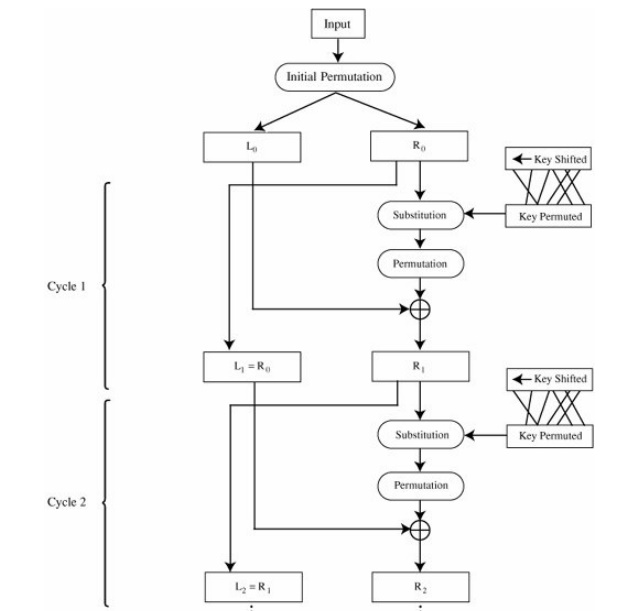
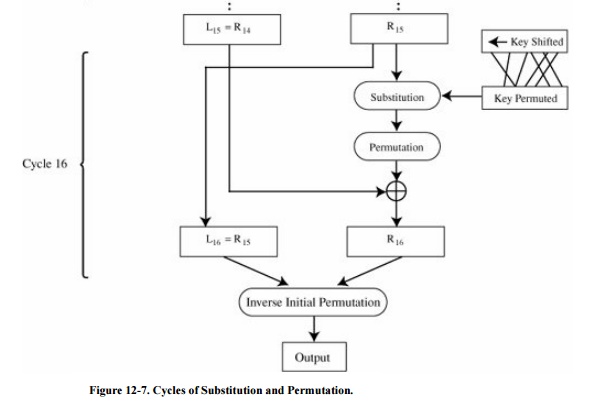
We noted in Chapter
2 that the algorithm uses only standard arithmetic and logical
operations on up to 64-bit numbers, so it is suitable for implementation in
software on most current computers. Although complex, the algorithm is
repetitive, making it suitable for implementation on a single-purpose chip. In
fact, several such chips are available on the market for use as basic
components in devices that use DES encryption in an application.
Details
of the Encryption Algorithm
The basis of the DES is two different ciphers,
applied alternately. Shannon noted that two weak but complementary ciphers can
be made more secure by being applied together (called the "product"
of the two ciphers) alternately, in a structure called a product cipher. The
product of two ciphers is depicted in Figure 12-8.
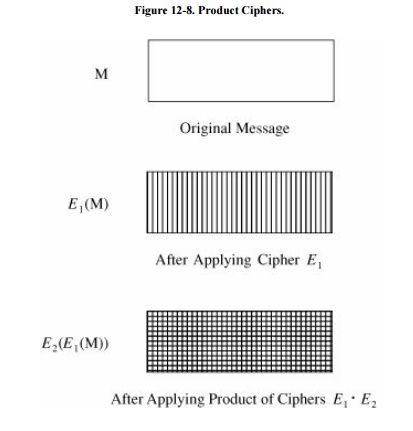
After initialization, the DES algorithm
operates on blocks of data. It splits a data block in half, scrambles each half
independently, combines the key with one half, and swaps the two halves. This
process is repeated 16 times. It is an iterative algorithm using just table
lookups and simple bit operations. Although the bit-level manipulations of the
algorithm are complex, the algorithm itself can be implemented quite
efficiently. The rest of this section identifies the individual steps of the
algorithm. In the next section, we describe each step in full detail.
Input to the DES is divided into blocks of 64
bits. The 64 data bits are permuted by a so-called initial permutation. The
data bits are transformed by a 64-bit key (of which only 56 bits are used). The
key is reduced from 64 bits to 56 bits by dropping bits 8, 16, 24, … 64 (where
the most significant bit is named bit "1"). These bits are assumed to
be parity bits that carry no information in the key.
Next begins the sequence of operations known as
a cycle. The 64 permuted data bits are broken into a left half and a right half
of 32 bits each. The key is shifted left by a number of bits and permuted. The
key is combined with the right half, which is then combined with the left half.
The result of these combinations becomes the new right half; the old right half
becomes the new left half. This sequence of activities, which constitutes a
cycle, is shown in Figure 12-9. The
cycles are repeated 16 times. After the last cycle is a final permutation,
which is the inverse of the initial permutation.
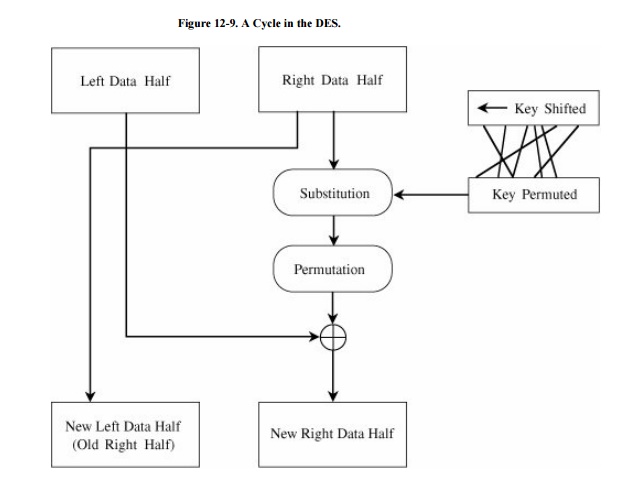
For a 32-bit right half to be combined with a
64 -bit key, two changes are needed. First, the algorithm expands the 32-bit
half to 48 bits by repeating certain bits, while reducing the 56-bit key to 48
bits by choosing only certain bits. These last two operations, called expansion permutations and permuted choices, are shown in the diagram of Figure
12-10.
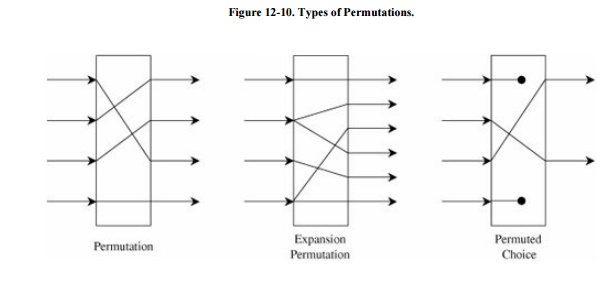
Details
of Each Cycle of the Algorithm
Each cycle of the algorithm is really four
separate operations. First, a right half is expanded from 32 bits to 48. Then,
it is combined with a form of the key. The result of this operation is then
substituted for another result and condensed to 32 bits at the same time. The
32 bits are permuted and then combined with the left half to yield a new right
half. This whole process is shown in Figure 12-11.
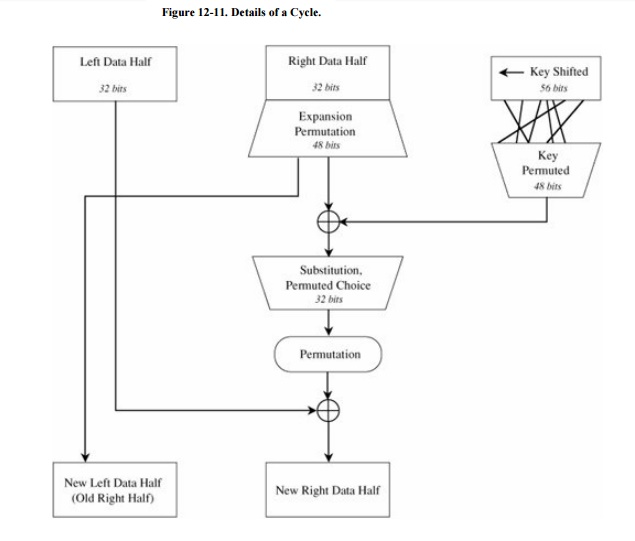
Expansion
Permutation
Each right half is expanded from 32 to 48 bits
by means of the expansion permutation. The expansion permutes the order of the
bits and also repeats certain bits. The expansion has two purposes: to make the
intermediate halves of the ciphertext comparable in size to the key and to
provide a longer result that can later be compressed.
The expansion permutation is defined by Table 12-1. For each 4-bit block, the first and
fourth bits are duplicated, while the second and third are used only once. This
table shows to which output position(s) the input bits move. Since this is an
expansion permutation, some bits move to more than one position. Each row of
the table shows the movement of eight bits. The interpretation of this table is
that bit 1 moves to positions 2 and 48 of the output, while bit 10 moves to
position 15. A portion of the pattern is also shown in Figure 12-12.


Key
Transformation
As described above, the 64-bit key immediately
becomes a 56-bit key by deletion of every eighth bit. At each step in the
cycle, the key is split into two 28 -bit halves, the halves are shifted left by
a specified number of digits, the halves are then pasted together again, and 48
of these 56 bits are permuted to use as a key during this cycle.
Next, the key for the cycle is combined by an
exclusive OR function with the expanded right half. That result moves into the
S-boxes we are about to describe.
At each cycle, the halves of the key are
independently shifted left circularly by a specified number of bit positions.
The number of bits shifted is given in Table 12-2.
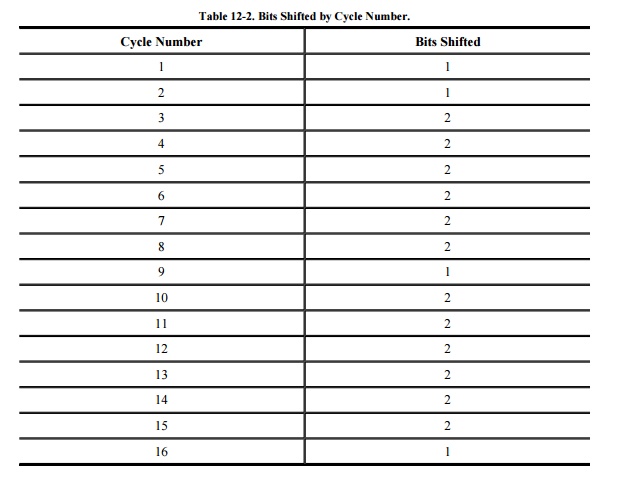
After being shifted, 48 of the 56 bits are
extracted for the exclusive OR combination with the expanded right half. The
choice permutation that selects these 48 bits is shown in Table 12-3. For example, from this table we see
that bit 1 of the shifted key goes to output position 5, and bit 9 is ignored
in this cycle.

S-Boxes
Substitutions are performed by eight S-boxes. An S-box is a permuted choice
function by which six bits of data are replaced by four bits. The 48-bit input
is divided into eight 6-bit blocks, identified as B1B2...
B8; block Bj is operated on by S-box Sj.
The S-boxes are substitutions based on a table
of 4 rows and 16 columns. Suppose that block Bj is the six bits b1b2b3b4b5b6.
Bits b1 and b6, taken together, form a two-bit binary
number b1b6, having a decimal value from 0 to 3. Call
this value r. Bits b2, b3, b4, and b5
taken together form a 4-bit binary number b2b3b4b5,
having a decimal value from 0 to 15. Call this value c. The substitutions from
the S-boxes transform each 6-bit block Bj into the 4-bit result
shown in row r, column c of section Si of Table 12-4. For example, assume that block B7 in
binary is 010011. Then, r = 01 = 1 and c = 1001 = 9. The transformation of
block B7 is found in row 1, column 9 of section 7 of Table 12-4. The value 3 = 0011 is substituted for the value 010011.
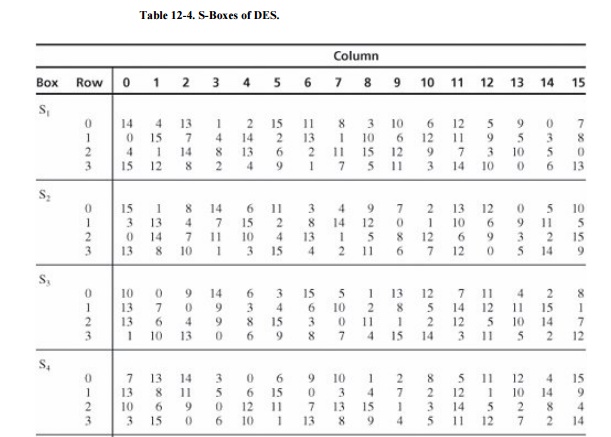
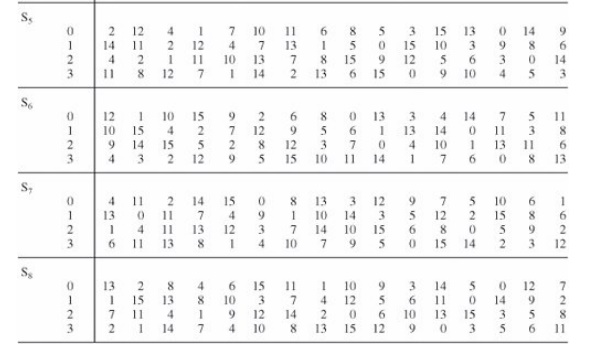
P-Boxes
After an S-box substitution, all 32 bits of a
result are permuted by a straight permutation, P. Table
12-5 shows the position to which bits are moved. Eight bits are
shown on each row. For example, bit 1 of the output of the substitution moves
to bit 9, and bit 10 moves to position 16.

Initial
and Final Permutations
The DES algorithm begins with an initial
permutation that reorders the 64 bits of each input block. The initial
permutation is shown in Table 12-6.
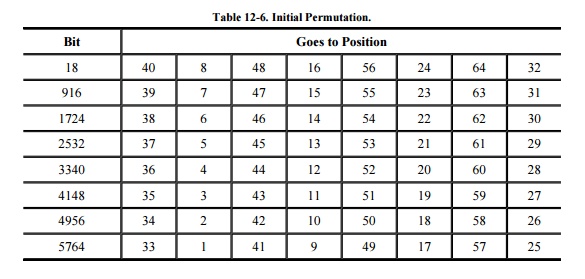
At the conclusion of the 16 substitutionpermutation
rounds, the DES algorithm finishes with a final permutation (or inverse initial
permutation), which is shown in Table 12-7.
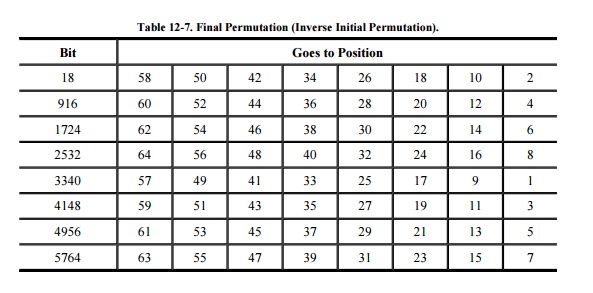
Complete
DES
Now we can put all the pieces back together.
First, the key is reduced to 56 bits. Then, a block of 64 data bits is permuted
by the initial permutation. Following are 16 cycles in which the key is shifted
and permuted, half of the data block is transformed with the substitution and
permutation functions, and the result is combined with the remaining half of
the data block. After the last cycle, the data block is permuted with the final
permutation.
Decryption
of the DES
The same DES algorithm is used both for
encryption and decryption. This result is true because cycle j derives from
cycle (j-1) in the following manner:
Equation (1)
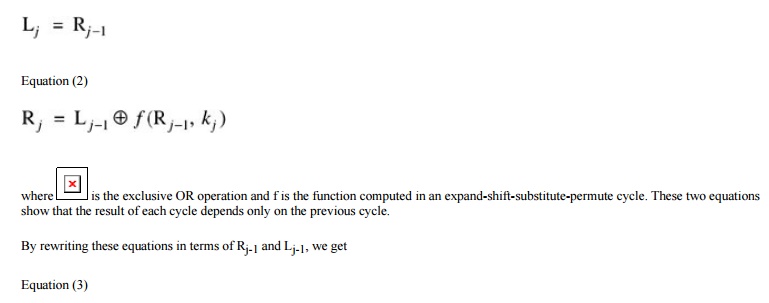
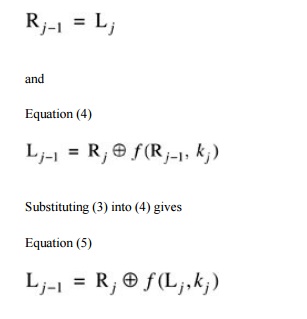
Equations (3) and (5) show that these same
values could be obtained from the results of later cycles. This property makes
the DES a reversible procedure; we can encrypt a string and also decrypt the
result to derive the plaintext again.
With the DES, the same function f is used
forward to encrypt or backward to decrypt. The only change is that the keys
must be taken in reverse order (k16, k15, ..., k1)
for decryption. Using one algorithm either to encrypt or to decrypt is very
convenient for a hardware or
software implementation of the DES.
Questions
About the Security of the DES
Since its first announcement, there has been
controversy concerning the security provided by the DES. Although much of this
controversy has appeared in the open literature, certain features of the DES
have neither been revealed by the designers nor inferred by outside analysts.
Design
of the Algorithm
Initially, there was concern with the basic
algorithm itself. During development of the algorithm, the National Security
Agency (NSA) indicated that key elements of the algorithm design were
"sensitive" and would not be made public. These elements include the
rationale behind transformations by the S-boxes, the P-boxes, and the key
changes. There are many possibilities for the S-box substitutions, but one
particular set was chosen for the DES.
Two issues arose about the design's secrecy.
The first involved a fear that certain "trapdoors" had been embedded
in the DES algorithm so that a covert, easy means was available to decrypt any
DES-encrypted message. For instance, such trapdoors would give NSA the ability
to inspect private communications.
After a Congressional inquiry, the results of
which are classified, an unclassified summary exonerated NSA from any improper
involvement in the DES design. (For a good discussion on the design of DES, see
[SMI88a].)
The second issue addressed the possibility that
a design flaw would be (or perhaps has been) discovered by a cryptanalyst, this
time giving an interceptor the ability to access private communications.
Both Bell Laboratories [MOR77] and the Lexan Corporation [LEX76] scrutinized the operation (not the
design) of the S -boxes. Neither analysis revealed any weakness that impairs
the proper functioning of the S-boxes. The DES algorithm has been studied
extensively and, to date, no serious flaws have been published.
In response to criticism, the NSA released
certain information on the selection of the S-boxes ([KON81, BRA77]).
No S-box is a linear or affine function of its
input; that is, the four output bits cannot be expressed as a system of linear
equations of the six input bits.
Changing one bit in the input of an S-box
results in changing at least two output bits; that is, the S-boxes diffuse
their information well throughout their outputs.
The S-boxes were chosen to minimize the
difference between the number of 1s and 0s when any single input bit is held
constant; that is, holding a single bit constant as a 0 or 1 and changing the
bits around it should not lead to disproportionately many 0s or 1s in the
output.
Number
of lterations
Many analysts wonder whether 16 iterations are
sufficient. Since each iteration diffuses the information of the plaintext
throughout the ciphertext, it is not clear that 16 cycles diffuse the
information sufficiently. For example, with only one cycle, a single ciphertext
bit is affected only by a few bits of plaintext. With more cycles, the
diffusion becomes greater, so ideally no one ciphertext bit depends on any
subset of plaintext bits.
Experimentation with both the DES and its IBM
predecessor Lucifer was performed by the NBS and by IBM as part of the
certification process of the DES algorithm. These experiments have shown [KON81] that 8 iterations are sufficient to
eliminate any observed dependence. Thus, the 16 iterations of the DES should
surely be adequate.
Key
Length
The length of the key is the most serious
objection raised. The key in the original IBM implementation of Lucifer was 128
bits, whereas the DES key is effectively only 56 bits long. The argument for a
longer key centers around the feasibility of an exhaustive search for a key.
Given a piece of plaintext known to be
enciphered as a particular piece of ciphertext, the goal for the interceptor is
to find the key under which the encipherment was done. This attack assumes that
the same key will be used to encipher other (unknown) plaintext. Knowing the
key, the interceptor can easily decipher intercepted ciphertext.
The attack strategy is the "brute
force" attack: Encipher the known plaintext with an orderly series of
keys, repeating with a new key until the enciphered plaintext matches the known
ciphertext. There are 256 56-bit keys. If someone could test one
every 100 milliseconds, the
time to test all keys would be 7.2 * 1015
seconds, or about 228 million years. If the test took only one microsecond,
then the total time for the search is (only!) about 2,280 years. Even supposing
the test time to be one nanosecond, infeasible on current technology machines,
the search time is still in excess of two years, assuming full-time work with
no hardware or software failures!
Diffie and Hellman [DIF77] suggest a parallel attack. With a parallel design, multiple processors can be assigned the same problem simultaneously. If one chip, working at a rate of one key per microsecond, can check about 8.6 * 1010 keys in one day, it would take 106 days to try all 256 7 * 1016 keys. However, 106 chips working in parallel at that rate could check all keys in one day.
Hellman's original estimate of the cost of such
a machine was $20 million (at 1977 prices). The price was subsequently revised
upward to $50 million. Assuming a "key shop" existed where people
would bring their plaintext/ciphertext pairs to obtain keys and assuming that
there was enough business to keep this machine busy 24 hours a day for 5 years,
the proportionate cost would be only about $20,000 per solution. As hardware
costs continue to fall, the cost of such a machine becomes lower. The stumbling
block in the economics of this argument is prorating the cost over five years:
If people learned such a device was available at affordable prices, use of the
DES would cease for important data. Hellman predicted [HEL79] that hardware prices would fall to the
point where this attack would be feasible.
There has been a dramatic drop in the price of
computing hardware per instruction per microsecond. In 1998 a piece of
special-purpose hardware was built that could infer a DES key in 112 hours for
only $130,000. Kocher [KOC99] describes
the machine. As the price of hardware continues to drop, the security of DES
continues to fall.
An alternative attack strategy is the table
lookup argument [HEL80]. For this
attack, assume a chosen plaintext attack. That is, assume we have the ability
to insert a given plaintext block into the encryption stream and obtain the
resulting ciphertext under a still-secret key.
Hellman argues that with enough advance time
and enough storage space, it would be possible to compute all of the 256
results of encrypting the chosen block under every possible key. Then,
determining which key was used is a matter of looking up the output obtained.
By a heuristic algorithm, Hellman suggests an
approach that will limit the amount of computation and data stored to 237,
or about 6.4 * 1011. Again assuming many DES devices working in
parallel, it would be possible to precompute and store results.
A brute force parallel attack against DES
succeeded in 1997. (Thus, the concerns about key length in 1977 were validated
in two decades.) Using the Internet, a team of researchers divided the key
search problem into pieces (so that computer A tries all keys beginning
0000..., computer B tries all keys beginning 0001..., computer C tries all keys
beginning 0010..., and so forth) . This attack works because the key space is
linear: any 56-bit string could be used as a key, and the parallel attack
simply divides the key space among all search machines. In four months, using
approximately 3500 machines, the researchers were able to recover a key to a
DES challenge posted by RSA Laboratories [KOC99].
This challenge required thousands of cooperating participants. It is doubtful
that such an attack could be accomplished in secret with public machines.
Because the approach is linear, 3500 machines in 120 days is equivalent to
35,000 machines in 12 days.
Weaknesses
of the DES
The DES algorithm also has known weaknesses,
but these weaknesses are not believed to be serious limitations of the
algorithm's effectiveness.
Complements
The first known weakness concerns complements.
(Throughout this discussion, "complement" means "ones
complement," the result obtained by replacing all 1s by 0s and 0s by 1s in
a binary number.) If a message is encrypted with a particular key, the
complement of that encryption will be the encryption of the complement message
under the complement key. Stated formally, let p represent a plaintext message
and k a key, and let the symbol ¬x mean the complement of the binary string x.
If c = DES(p, k) (meaning c is the DES encryption of p using key k), then ¬c =
DES(¬p, ¬k). Since most applications of encryption do not deal with complement
messages and since users can be warned not to use complement keys, this problem
is not serious.
Weak
Keys
A second known weakness concerns choice of
keys. Because the initial key is split into two halves and the two halves are
independently shifted circularly, if the value being shifted is all 0s or all
1s, then the key used for encryption in each cycle is the same as for all other
cycles. Remember that the difference between encryption and decryption is that
the key shifts are applied in reverse. Key shifts are right shifts, and the
number of positions shifted is taken from the bottom of the table up, instead
of top down. But if the keys are all 0s or all 1s anyway, right or left shifts
by 0, 1, or 2 positions are all the same. For these keys, encryption is the
same as decryption: c = DES(p, k), and p = DES(c, k). These keys are called
"weak keys." The same thing happens if one half of the key is all 0s
and the other half is all 1s. Since these keys are known, they can simply be
avoided, so this, too, is not a serious problem.
The four weak keys are shown in hexadecimal
notation in Table 12-8. (The initial key
permutation extracts every eighth bit as a parity bit and scrambles the key
order slightly. Therefore, the "half zeros, half ones" keys are not
just split in the middle.)

Semiweak
Keys
A third difficulty is similar: Specific pairs
of keys have identical decryption. That is, there are two different keys, k1
and k2, for which c = DES(p, k1) and c = DES(p, k2).
This similarity implies that k1 can decrypt a message encrypted
under k2. These socalled semiweak keys are shown in Table 12-9. Other key patterns have been
investigated with no additional weaknesses found to date. We should, however,
avoid any key having an obvious pattern such as these.

Design
Weaknesses
In another analysis of the DES, [DAV83b] shows that the expansion permutation
repeats the first and fourth bits of every 4-bit series, crossing bits from
neighboring 4-bit series. This analysis further indicates that in S-box S4, one
can derive the last three output bits the same way as the first by
complementing some of the input bits. Of course, this small weakness raises the
question of whether there are similar weaknesses in other S-boxes or in pairs
of S-boxes.
It has also been shown that two different, but
carefully chosen, inputs to S-boxes can produce the same output (see [DAV83b]). Desmedt et al. [DES84] make the point that in a single cycle, by
changing bits only in three neighboring S-boxes, it is possible to obtain the
same output; that is, two slightly different inputs, encrypted under the same
key, will produce identical results at the end of just one of the l6 cycles.
Key
Clustering
Finally, the researchers in [DES84] investigate a phenomenon called "key
clustering." They seek to determine whether two different keys can
generate the same ciphertext from the same plaintext, that is, two keys can
produce the same encryption. The semiweak keys are key clusters, but the
researchers seek others. Their analysis is very involved, looking at
ciphertexts that produce identical plaintext with different keys in one cycle
of the DES, then looking at two cycles, then three, and so forth. Up through
three cycles, they found key clusters. Because of the complexity involved, they
had to stop the analysis after three cycles.
Differential
Cryptanalysis
These inherent design problemsweak keys, key
clustering, and so forthwere all discovered through intensive research into the
strength of DES shortly after its introduction. Although the results are
significant from the standpoint of cryptologists, none of them called into
question the overall usefulness of DES.
In 1990 Biham and Shamir [BIH90] (see also [BIH91,
BIH92, and BIH93])
announced a technique they named differential
cryptanalysis. The technique applied to cryptographic algorithms that use
substitution and permutation. This powerful technique was the first to have
impressive effects against a broad range of algorithms of this type.
The technique uses carefully selected pairs of
plaintext with subtle differences and studies the effects of these differences
on resulting ciphertexts. If particular combinations of input bits are modified
simultaneously, particular intermediate bits are also likely with a high
probability to change in a particular way. The technique looks at the exclusive
OR (XOR) of a pair of inputs; the XOR will have a 0 in any bit in which the
inputs are identical and a 1 where they differ.
The full analysis is rather complicated, but we
present a sketch of it here. The S-boxes transform six bits into four. If the
S-boxes were perfectly uniform, one would expect all 4-bit outputs to be
equally likely. However, as Biham and Shamir show, certain similar texts are
more likely to produce similar outputs than others. For example, examining all
pairs of 6-bit strings with an XOR pattern 35 in hexadecimal notation (that is,
strings of the form ddsdsd where d means the bit value is different between the
two strings and s means the bit value is the same) for S-box S1, the
researchers found that the pairs have an output pattern of dsss 14 times, ddds
14 times, and all other patterns a
frequency ranging between 0 and 8. That says
that an input of the form ddsdsd has an output of the form dsss 14 times out of
64, and ddds another 14 times out of 64; each of these results is almost 1/4,
which continues to the next round. Biham and Shamir call each of these
recognizable effects a "characteristic"; they then extend their
result by concatenating characteristics. The attack lets them infer values in
specific positions of the key. If m bits of a
k-bit key can be found, the remaining (k-m) bits can be found in an exhaustive
search of all 2(k-m) possible keys; if m is large enough, the 2(k-m)
exhaustive search is feasible.
In Biham and Shamir [BIH90] the authors present the conclusions of many results they have produced by using differential cryptanalysis; they describe the details of these results in the succeeding papers. The attack on Lucifer, the IBM-designed predecessor to DES, succeeds with only 30 ciphertext pairs. FEAL is an algorithm similar to DES that uses any number of rounds; the n-round version is called FEAL-n.
FEAL-4 can be broken with 20 chosen plaintext items [MUR90], FEAL-8 [MIY89] with 10,000 pairs [GIL90]; and FEAL-n for n 31 can be broken faster by differential cryptanalysis than by full exhaustive search [BIH91].
The results concerning DES are impressive.
Shortening DES to fewer than its normal 16 rounds allows a key to be determined
from chosen ciphertexts in fewer than the 256 (actually, expected
value of 255) searches. For example, with 15 rounds, only 252
tests are needed (which is still a large number of tests); with 10 rounds, the
number of tests falls to 235, and with 6 rounds, only 28
tests are needed. However, with the full 16 rounds, this technique requires 258
tests, or 22 = 4 times more than an exhaustive search would require.
Finally, the authors show that with randomly
selected S-box values, DES is easy to break. Indeed, even with a change of only
one entry in one S-box, DES becomes easy to break. One might conclude that the
design of the S-boxes and the number of rounds were chosen to be optimal.
In fact, that is true. Don Coppersmith of IBM,
one of the original team working on Lucifer and DES, acknowledged [COP92] that the technique of differential
cryptanalysis was known to the design team in 1974 when they were designing
DES. The S-boxes and permutations were chosen in such a way as to defeat that
line of attack.
Security
of the DES
The cryptanalytic attacks described here have
not exposed any significant, exploitable vulnerabilities in the design of DES.
But the weakness of the 56-bit key is now apparent. Although the amount of
computing power or time needed is still significant enough to deter casual DES
key browsing, a dedicated adversary could succeed against a specific DES
ciphertext of significant interest.
Does this mean the DES is insecure? No, not
yet. Nobody has yet shown serious flaws in the DES. With a triple DES approach
(described
in Chapter 2),
the effective key length is raised from 56 bits to 112 or 168 bits,[4] increasing the difficulty of attack
exponentially. In the near term (years, probably decades) triple DES is strong
enough to protect even significant commercial data (such as financial data or
patient medical records). Still, DES is nearing the end of its useful lifetime,
and a replacement is in order. With millions of computers in the world, clearly
DES is inadequate to protect sensitive information with a modest time value.
Similarly, algorithms with key lengths of 64 and 80 bits may be strong enough
for a while, but an improvement in processor speeds and number of parallel
computers threatens those, too. (See [BLA96]
and [LEN01] for more discussion on the
relationship between key length and security with various algorithms.)
Related Topics